Toyota Brand Market Segmentation: Analysis of Target Market in USA
VerifiedAdded on 2023/06/05
|12
|2273
|308
Report
AI Summary
This report provides a market segmentation analysis of the Toyota brand in the United States, focusing on demographic segmentation based on income levels. It identifies three key segments: the lower middle class, upper middle class, and upper class, detailing their characteristics, purchasing influences, and the Toyota vehicles targeted at each group. The report assesses the relative attractiveness of each segment, considering factors like market size, growth potential, and competition. Ultimately, it concludes that the upper middle-class segment represents Toyota's primary target market due to its growth potential, size, limited competition, and market effectiveness. The analysis considers factors such as customer loyalty, brand perception, and competitive advantages in the US automotive market.
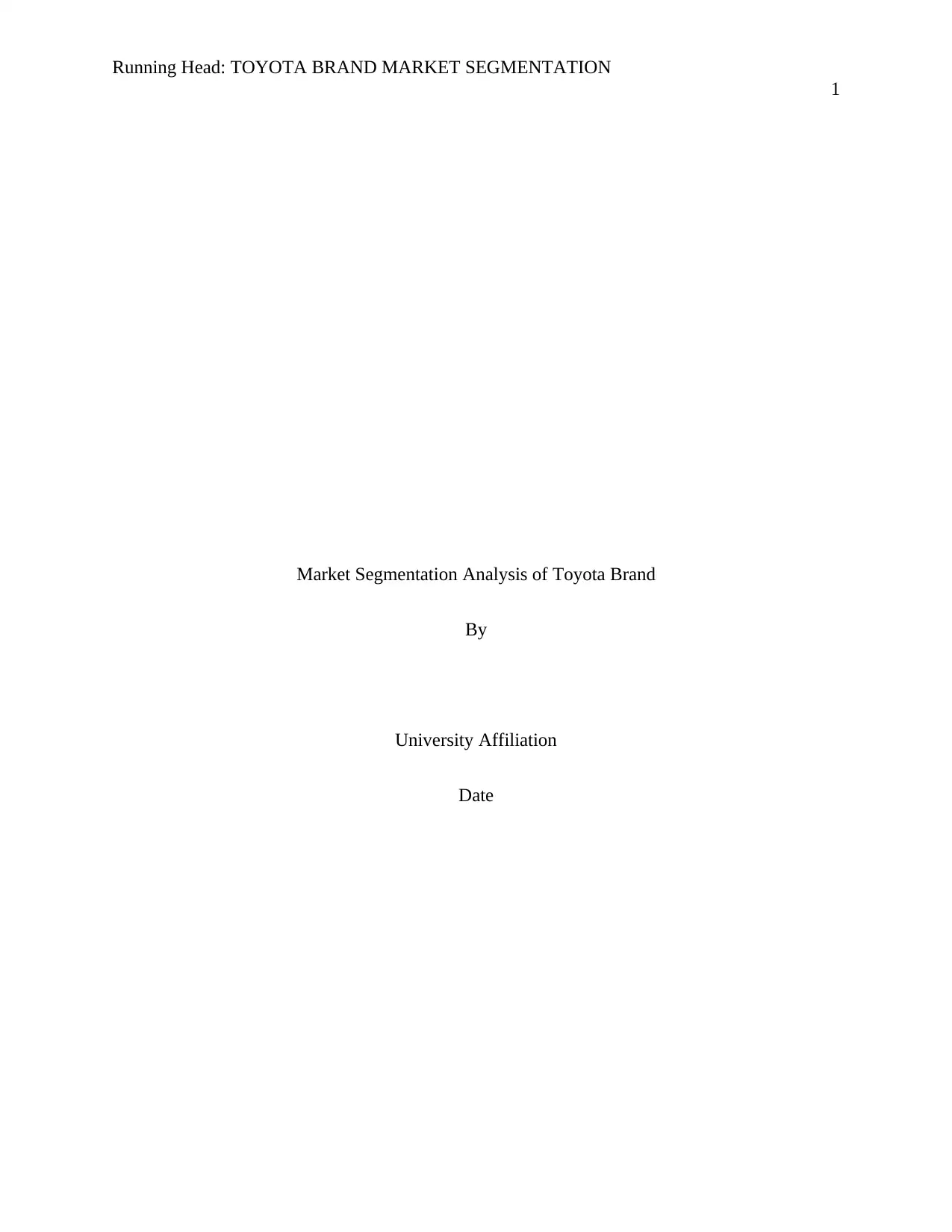
Running Head: TOYOTA BRAND MARKET SEGMENTATION
1
Market Segmentation Analysis of Toyota Brand
By
University Affiliation
Date
1
Market Segmentation Analysis of Toyota Brand
By
University Affiliation
Date
Paraphrase This Document
Need a fresh take? Get an instant paraphrase of this document with our AI Paraphraser

TOYOTA BRAND MARKET SEGMENTATION 2
Table of Contents
Cover Page…………………………………………………………………………………. 1
Brand Choice……………………………………………………………………………….. 3
Market Segmentation and Description Using Customer Segmentation Framework……...... 3
Relative Attractiveness of the Segments…………………………………………………..... 5
Primary Target Market……………………………………………………………………… 6
Appendices………………………………………………………………………………….. 9
References……………………………………………………………………………………11
Table of Contents
Cover Page…………………………………………………………………………………. 1
Brand Choice……………………………………………………………………………….. 3
Market Segmentation and Description Using Customer Segmentation Framework……...... 3
Relative Attractiveness of the Segments…………………………………………………..... 5
Primary Target Market……………………………………………………………………… 6
Appendices………………………………………………………………………………….. 9
References……………………………………………………………………………………11

TOYOTA BRAND MARKET SEGMENTATION 3
Brand Choice
Toyota Motor Corporation is a Japan-based multinational automobile and automobile
spare parts manufacturer with its headquarters in Toyota city. The corporation was established by
Toyoda Sakichi in 1933 as a subsidiary of Toyoda Automatic Loom Works Ltd (Toyota Motor
Corporation, 2018). It is among the world’s top three automobile manufactures with over seventy
production facilities across the globe, which produce over ten million vehicles per year. The
company is well known for adopting technology in its production thus increasing its productivity
and efficiency of its automobiles.
Toyota Motor Corporation has partnered with several companies since its inception.
These companies form its divisions with the largest divisions being; the Toyota Brand, Hino
brand, Lexus brand, Ranz brand, Daihatsu brand (Toyota Motor Corporation, 2018). Toyota
brand is the largest division and most popular among many motor vehicle owners in the world,
therefore, this market segmentation analysis focuses on the Toyota brand in the United States of
America.
Market Segmentation and Description Using Customer Segmentation Framework
Toyota provides a variety of vehicles to United States of America residents, the vehicles
are differentiated to meet the needs of particular market segments. The major framework that
Toyota can use to segment its market is the demographic framework under which it would focus
on the level of income/ income status of the residents, in which there are three market segments
which are:
Lower Middle class: This refers to the category of people who earn an average annual
income that ranges between $30000- $100000. It mainly consists of blue-collar jobs which
Brand Choice
Toyota Motor Corporation is a Japan-based multinational automobile and automobile
spare parts manufacturer with its headquarters in Toyota city. The corporation was established by
Toyoda Sakichi in 1933 as a subsidiary of Toyoda Automatic Loom Works Ltd (Toyota Motor
Corporation, 2018). It is among the world’s top three automobile manufactures with over seventy
production facilities across the globe, which produce over ten million vehicles per year. The
company is well known for adopting technology in its production thus increasing its productivity
and efficiency of its automobiles.
Toyota Motor Corporation has partnered with several companies since its inception.
These companies form its divisions with the largest divisions being; the Toyota Brand, Hino
brand, Lexus brand, Ranz brand, Daihatsu brand (Toyota Motor Corporation, 2018). Toyota
brand is the largest division and most popular among many motor vehicle owners in the world,
therefore, this market segmentation analysis focuses on the Toyota brand in the United States of
America.
Market Segmentation and Description Using Customer Segmentation Framework
Toyota provides a variety of vehicles to United States of America residents, the vehicles
are differentiated to meet the needs of particular market segments. The major framework that
Toyota can use to segment its market is the demographic framework under which it would focus
on the level of income/ income status of the residents, in which there are three market segments
which are:
Lower Middle class: This refers to the category of people who earn an average annual
income that ranges between $30000- $100000. It mainly consists of blue-collar jobs which
⊘ This is a preview!⊘
Do you want full access?
Subscribe today to unlock all pages.

Trusted by 1+ million students worldwide
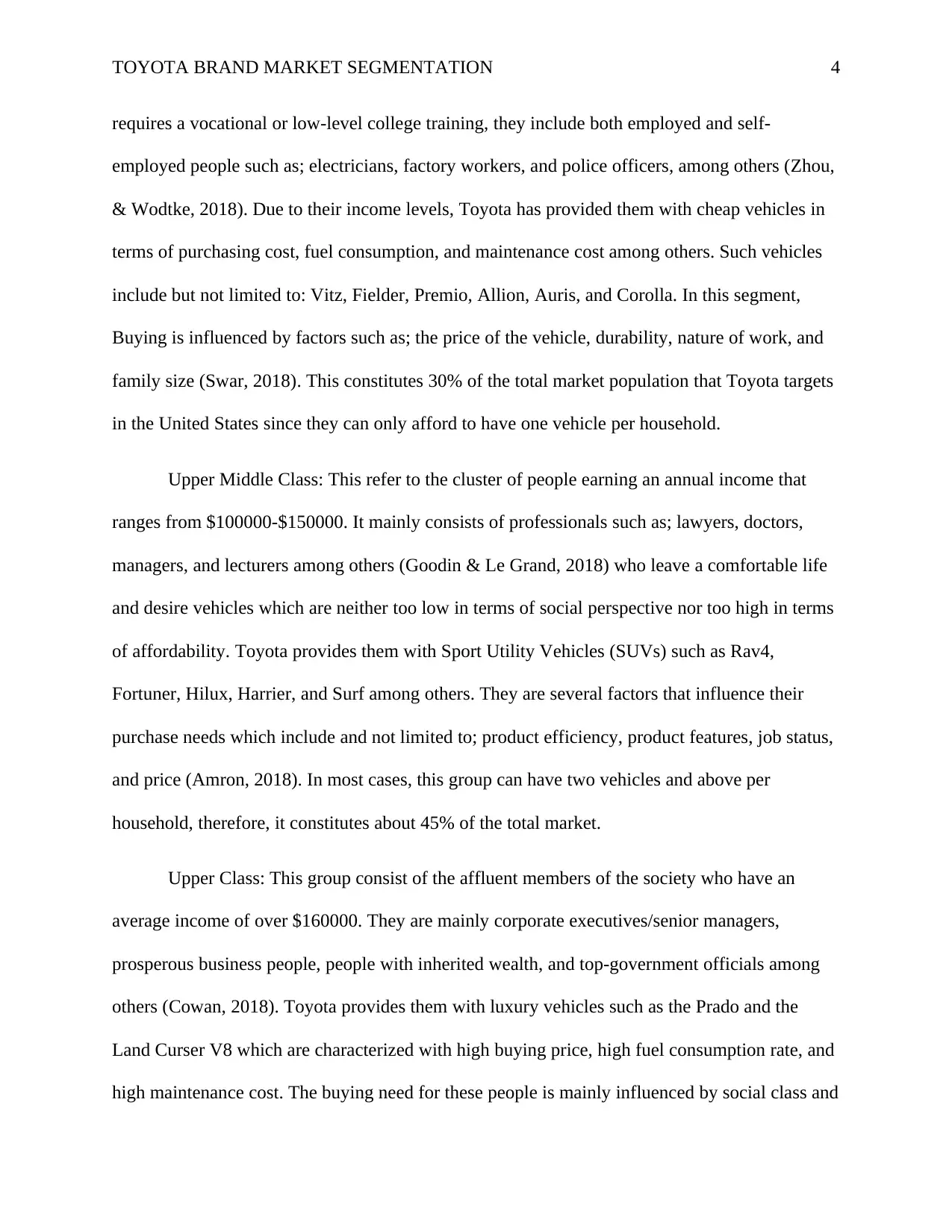
TOYOTA BRAND MARKET SEGMENTATION 4
requires a vocational or low-level college training, they include both employed and self-
employed people such as; electricians, factory workers, and police officers, among others (Zhou,
& Wodtke, 2018). Due to their income levels, Toyota has provided them with cheap vehicles in
terms of purchasing cost, fuel consumption, and maintenance cost among others. Such vehicles
include but not limited to: Vitz, Fielder, Premio, Allion, Auris, and Corolla. In this segment,
Buying is influenced by factors such as; the price of the vehicle, durability, nature of work, and
family size (Swar, 2018). This constitutes 30% of the total market population that Toyota targets
in the United States since they can only afford to have one vehicle per household.
Upper Middle Class: This refer to the cluster of people earning an annual income that
ranges from $100000-$150000. It mainly consists of professionals such as; lawyers, doctors,
managers, and lecturers among others (Goodin & Le Grand, 2018) who leave a comfortable life
and desire vehicles which are neither too low in terms of social perspective nor too high in terms
of affordability. Toyota provides them with Sport Utility Vehicles (SUVs) such as Rav4,
Fortuner, Hilux, Harrier, and Surf among others. They are several factors that influence their
purchase needs which include and not limited to; product efficiency, product features, job status,
and price (Amron, 2018). In most cases, this group can have two vehicles and above per
household, therefore, it constitutes about 45% of the total market.
Upper Class: This group consist of the affluent members of the society who have an
average income of over $160000. They are mainly corporate executives/senior managers,
prosperous business people, people with inherited wealth, and top-government officials among
others (Cowan, 2018). Toyota provides them with luxury vehicles such as the Prado and the
Land Curser V8 which are characterized with high buying price, high fuel consumption rate, and
high maintenance cost. The buying need for these people is mainly influenced by social class and
requires a vocational or low-level college training, they include both employed and self-
employed people such as; electricians, factory workers, and police officers, among others (Zhou,
& Wodtke, 2018). Due to their income levels, Toyota has provided them with cheap vehicles in
terms of purchasing cost, fuel consumption, and maintenance cost among others. Such vehicles
include but not limited to: Vitz, Fielder, Premio, Allion, Auris, and Corolla. In this segment,
Buying is influenced by factors such as; the price of the vehicle, durability, nature of work, and
family size (Swar, 2018). This constitutes 30% of the total market population that Toyota targets
in the United States since they can only afford to have one vehicle per household.
Upper Middle Class: This refer to the cluster of people earning an annual income that
ranges from $100000-$150000. It mainly consists of professionals such as; lawyers, doctors,
managers, and lecturers among others (Goodin & Le Grand, 2018) who leave a comfortable life
and desire vehicles which are neither too low in terms of social perspective nor too high in terms
of affordability. Toyota provides them with Sport Utility Vehicles (SUVs) such as Rav4,
Fortuner, Hilux, Harrier, and Surf among others. They are several factors that influence their
purchase needs which include and not limited to; product efficiency, product features, job status,
and price (Amron, 2018). In most cases, this group can have two vehicles and above per
household, therefore, it constitutes about 45% of the total market.
Upper Class: This group consist of the affluent members of the society who have an
average income of over $160000. They are mainly corporate executives/senior managers,
prosperous business people, people with inherited wealth, and top-government officials among
others (Cowan, 2018). Toyota provides them with luxury vehicles such as the Prado and the
Land Curser V8 which are characterized with high buying price, high fuel consumption rate, and
high maintenance cost. The buying need for these people is mainly influenced by social class and
Paraphrase This Document
Need a fresh take? Get an instant paraphrase of this document with our AI Paraphraser

TOYOTA BRAND MARKET SEGMENTATION 5
status quo (Swar, 2018), they, therefore, desire more customized vehicles that will meet their
luxury needs and give them the desired status.
Relative Attractiveness of the Segments
Relative market segmentation refers to how suitable a market is to an organization in
terms of size, growth, and profitability of the segment (Liu, Liao, Huang, & Liao, 2018). The
three market segments that Toyota brand can have in the United States of America vary in
attractiveness due to the differentiated features of each market segment. The attractiveness can
be analyzed and ranked as follows:
Lower Middle-class market segment: This can be ranked as an attractive market segment
due to various factors such as; it has a large size in the United States thus it can generate good
revenue, it is the first stage that majority of US residents go through in their life especially those
with no inherited wealth thus it has a high potential of being a sustainable market, the vehicles
that are sold to this particular market segment requires no customization and therefore the
company can manage to mass produce similar vehicles thus minimizing production cost and
maximizing profitability (Kursar & Gopinath, 2016), and the segment has low competition since
Toyota vehicles are relatively cheaper than other competitor brands such as Volkswagen, Honda,
and Nissan, among others.
Upper Middle-class market segment: it is an attractive market segments for Toyota
Company since it bears the following features: it is less sensitive to price, therefore, immunizing
the Company from customer loss as a result of price increase due to external factors such as
taxation and variations in the growth of the economy (Hashmi & Biesebroeck, 2016). Secondly,
the segment requires less investment in marketing since majority of US residents already have a
status quo (Swar, 2018), they, therefore, desire more customized vehicles that will meet their
luxury needs and give them the desired status.
Relative Attractiveness of the Segments
Relative market segmentation refers to how suitable a market is to an organization in
terms of size, growth, and profitability of the segment (Liu, Liao, Huang, & Liao, 2018). The
three market segments that Toyota brand can have in the United States of America vary in
attractiveness due to the differentiated features of each market segment. The attractiveness can
be analyzed and ranked as follows:
Lower Middle-class market segment: This can be ranked as an attractive market segment
due to various factors such as; it has a large size in the United States thus it can generate good
revenue, it is the first stage that majority of US residents go through in their life especially those
with no inherited wealth thus it has a high potential of being a sustainable market, the vehicles
that are sold to this particular market segment requires no customization and therefore the
company can manage to mass produce similar vehicles thus minimizing production cost and
maximizing profitability (Kursar & Gopinath, 2016), and the segment has low competition since
Toyota vehicles are relatively cheaper than other competitor brands such as Volkswagen, Honda,
and Nissan, among others.
Upper Middle-class market segment: it is an attractive market segments for Toyota
Company since it bears the following features: it is less sensitive to price, therefore, immunizing
the Company from customer loss as a result of price increase due to external factors such as
taxation and variations in the growth of the economy (Hashmi & Biesebroeck, 2016). Secondly,
the segment requires less investment in marketing since majority of US residents already have a
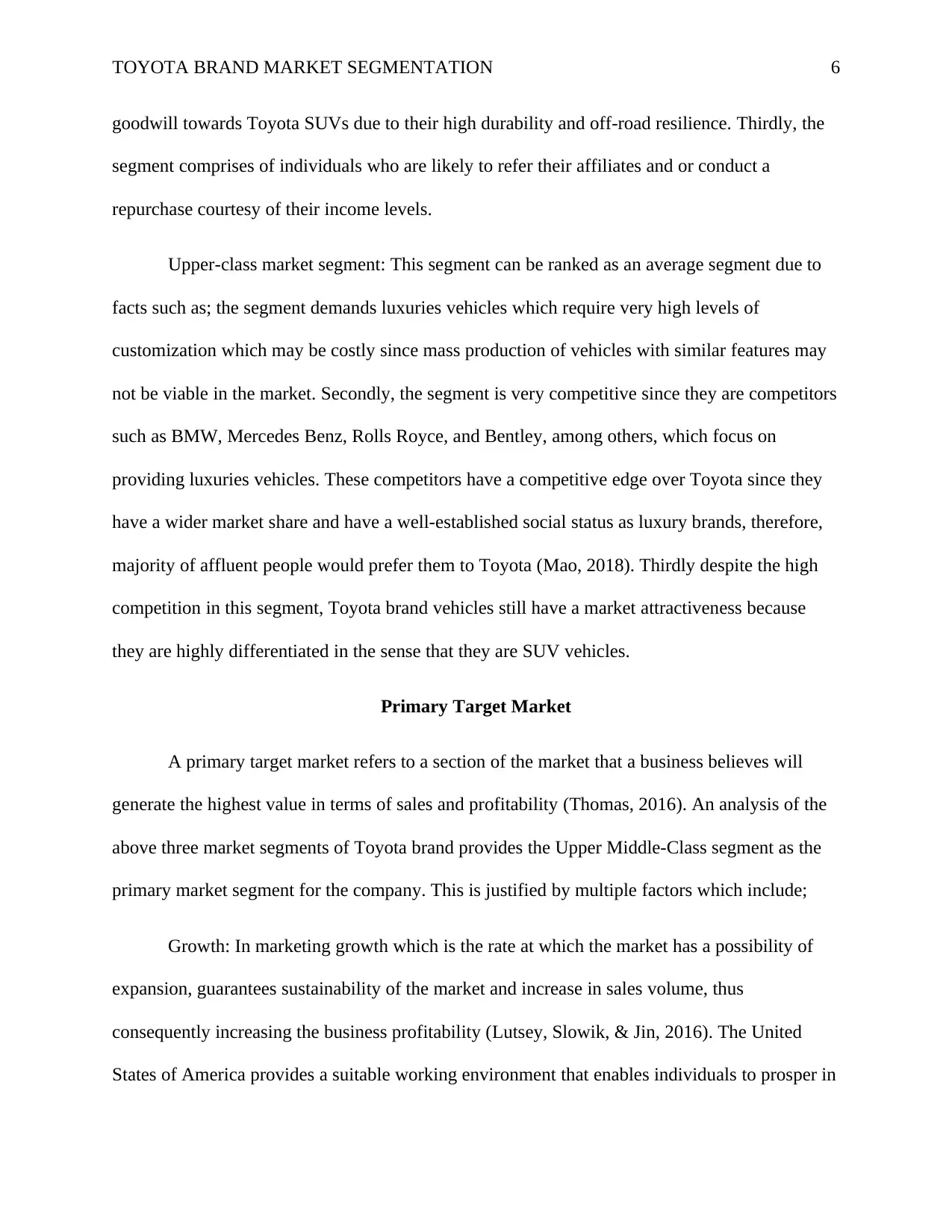
TOYOTA BRAND MARKET SEGMENTATION 6
goodwill towards Toyota SUVs due to their high durability and off-road resilience. Thirdly, the
segment comprises of individuals who are likely to refer their affiliates and or conduct a
repurchase courtesy of their income levels.
Upper-class market segment: This segment can be ranked as an average segment due to
facts such as; the segment demands luxuries vehicles which require very high levels of
customization which may be costly since mass production of vehicles with similar features may
not be viable in the market. Secondly, the segment is very competitive since they are competitors
such as BMW, Mercedes Benz, Rolls Royce, and Bentley, among others, which focus on
providing luxuries vehicles. These competitors have a competitive edge over Toyota since they
have a wider market share and have a well-established social status as luxury brands, therefore,
majority of affluent people would prefer them to Toyota (Mao, 2018). Thirdly despite the high
competition in this segment, Toyota brand vehicles still have a market attractiveness because
they are highly differentiated in the sense that they are SUV vehicles.
Primary Target Market
A primary target market refers to a section of the market that a business believes will
generate the highest value in terms of sales and profitability (Thomas, 2016). An analysis of the
above three market segments of Toyota brand provides the Upper Middle-Class segment as the
primary market segment for the company. This is justified by multiple factors which include;
Growth: In marketing growth which is the rate at which the market has a possibility of
expansion, guarantees sustainability of the market and increase in sales volume, thus
consequently increasing the business profitability (Lutsey, Slowik, & Jin, 2016). The United
States of America provides a suitable working environment that enables individuals to prosper in
goodwill towards Toyota SUVs due to their high durability and off-road resilience. Thirdly, the
segment comprises of individuals who are likely to refer their affiliates and or conduct a
repurchase courtesy of their income levels.
Upper-class market segment: This segment can be ranked as an average segment due to
facts such as; the segment demands luxuries vehicles which require very high levels of
customization which may be costly since mass production of vehicles with similar features may
not be viable in the market. Secondly, the segment is very competitive since they are competitors
such as BMW, Mercedes Benz, Rolls Royce, and Bentley, among others, which focus on
providing luxuries vehicles. These competitors have a competitive edge over Toyota since they
have a wider market share and have a well-established social status as luxury brands, therefore,
majority of affluent people would prefer them to Toyota (Mao, 2018). Thirdly despite the high
competition in this segment, Toyota brand vehicles still have a market attractiveness because
they are highly differentiated in the sense that they are SUV vehicles.
Primary Target Market
A primary target market refers to a section of the market that a business believes will
generate the highest value in terms of sales and profitability (Thomas, 2016). An analysis of the
above three market segments of Toyota brand provides the Upper Middle-Class segment as the
primary market segment for the company. This is justified by multiple factors which include;
Growth: In marketing growth which is the rate at which the market has a possibility of
expansion, guarantees sustainability of the market and increase in sales volume, thus
consequently increasing the business profitability (Lutsey, Slowik, & Jin, 2016). The United
States of America provides a suitable working environment that enables individuals to prosper in
⊘ This is a preview!⊘
Do you want full access?
Subscribe today to unlock all pages.

Trusted by 1+ million students worldwide

TOYOTA BRAND MARKET SEGMENTATION 7
their careers thus increasing the chances of a re-purchase by existing customers. Secondly,
customers in the Lower Middle-Class have high chances of progressing to this segment thus
guaranteeing growth of the market.
Size: Size of a market segment constitutes the percentage dominance of the segment in
the entire market (Behrens, Pokrovsky, & Zhelobodko, 2018). The Upper Middle-Class people
constitute the highest number of motor vehicles buyers in the United States of America. This is
due to the high growth of the country’s economy thus giving a thriving opportunity for the
people in this class. The United States also provides high standards of education which are
mostly sort after by many people, therefore, the country has a high number of both domestic and
foreign professionals.
Competition: This incorporates the number of competitors in the market, their level of
competition, and the organization’s position in the market (Mao, 2018). In the Upper Middle-
Class segment, Toyota brand has little competition it is actually a market leader. This is because
Toyota brand vehicles in this segment are cheap to buy and maintain when compared to other
competitors such as Ford, they are multiple differentiated vehicle types in this cluster which
gives the customers the luxury of choice based on their needs and interest, thus surpassing the
competitors. Due to this competitive edge, the company will make more sales and consequently
result to higher profits in this segment than in any other.
Market effectiveness: it refers to how suitable a market is to a business in relation to how
easy it is to sell in the market (Porral & Stanton, 2017). In this market segment, Toyota brand
will enjoy the benefit of reduced marketing cost due to the popularity of the brand and the
vehicles under this market group among many people in the United States. Secondly, vehicles in
their careers thus increasing the chances of a re-purchase by existing customers. Secondly,
customers in the Lower Middle-Class have high chances of progressing to this segment thus
guaranteeing growth of the market.
Size: Size of a market segment constitutes the percentage dominance of the segment in
the entire market (Behrens, Pokrovsky, & Zhelobodko, 2018). The Upper Middle-Class people
constitute the highest number of motor vehicles buyers in the United States of America. This is
due to the high growth of the country’s economy thus giving a thriving opportunity for the
people in this class. The United States also provides high standards of education which are
mostly sort after by many people, therefore, the country has a high number of both domestic and
foreign professionals.
Competition: This incorporates the number of competitors in the market, their level of
competition, and the organization’s position in the market (Mao, 2018). In the Upper Middle-
Class segment, Toyota brand has little competition it is actually a market leader. This is because
Toyota brand vehicles in this segment are cheap to buy and maintain when compared to other
competitors such as Ford, they are multiple differentiated vehicle types in this cluster which
gives the customers the luxury of choice based on their needs and interest, thus surpassing the
competitors. Due to this competitive edge, the company will make more sales and consequently
result to higher profits in this segment than in any other.
Market effectiveness: it refers to how suitable a market is to a business in relation to how
easy it is to sell in the market (Porral & Stanton, 2017). In this market segment, Toyota brand
will enjoy the benefit of reduced marketing cost due to the popularity of the brand and the
vehicles under this market group among many people in the United States. Secondly, vehicles in
Paraphrase This Document
Need a fresh take? Get an instant paraphrase of this document with our AI Paraphraser

TOYOTA BRAND MARKET SEGMENTATION 8
this category can easily be sold through local motor vehicle dealers since they will give the
dealer less complexity and high-profit margins as opposed to vehicles in the other segments.
this category can easily be sold through local motor vehicle dealers since they will give the
dealer less complexity and high-profit margins as opposed to vehicles in the other segments.
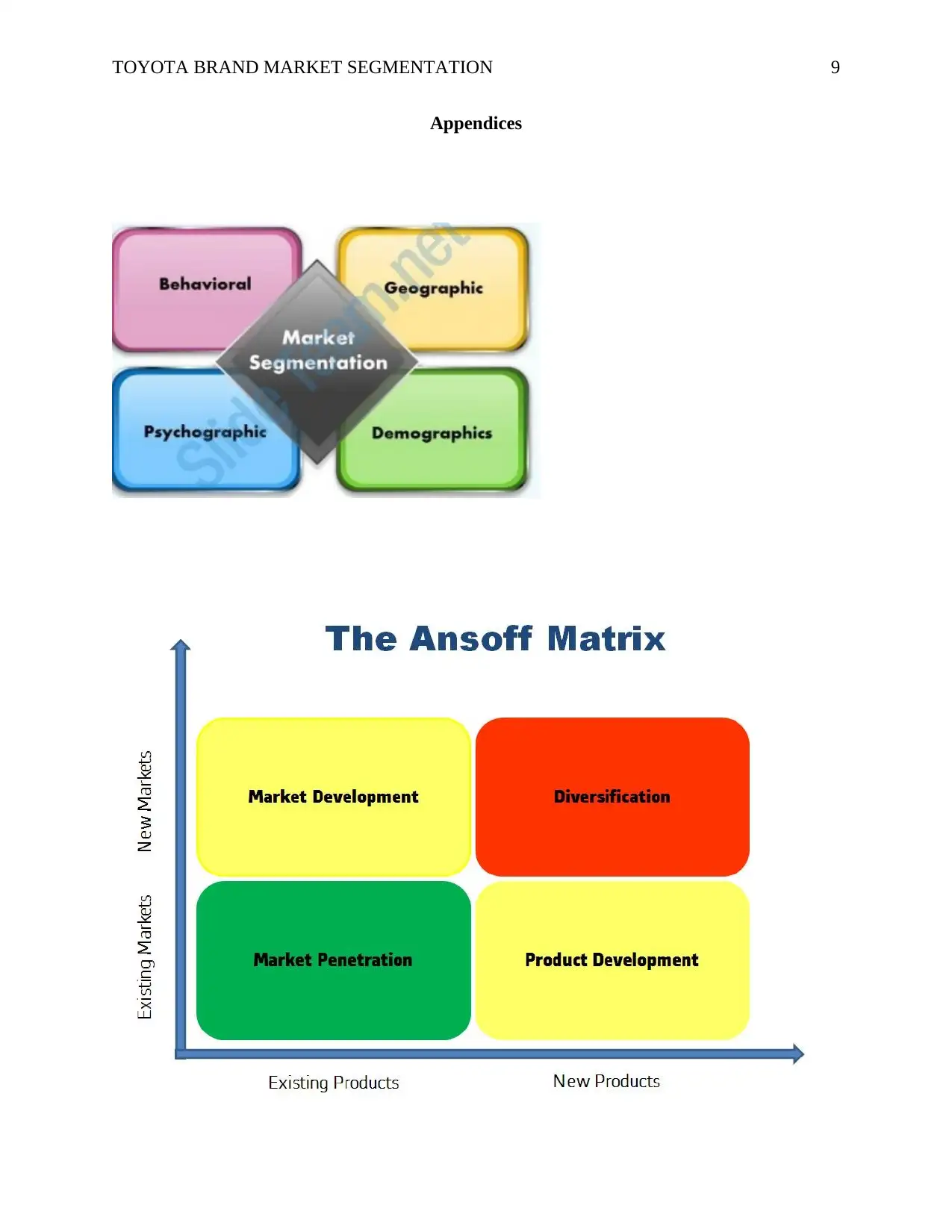
TOYOTA BRAND MARKET SEGMENTATION 9
Appendices
Appendices
⊘ This is a preview!⊘
Do you want full access?
Subscribe today to unlock all pages.

Trusted by 1+ million students worldwide
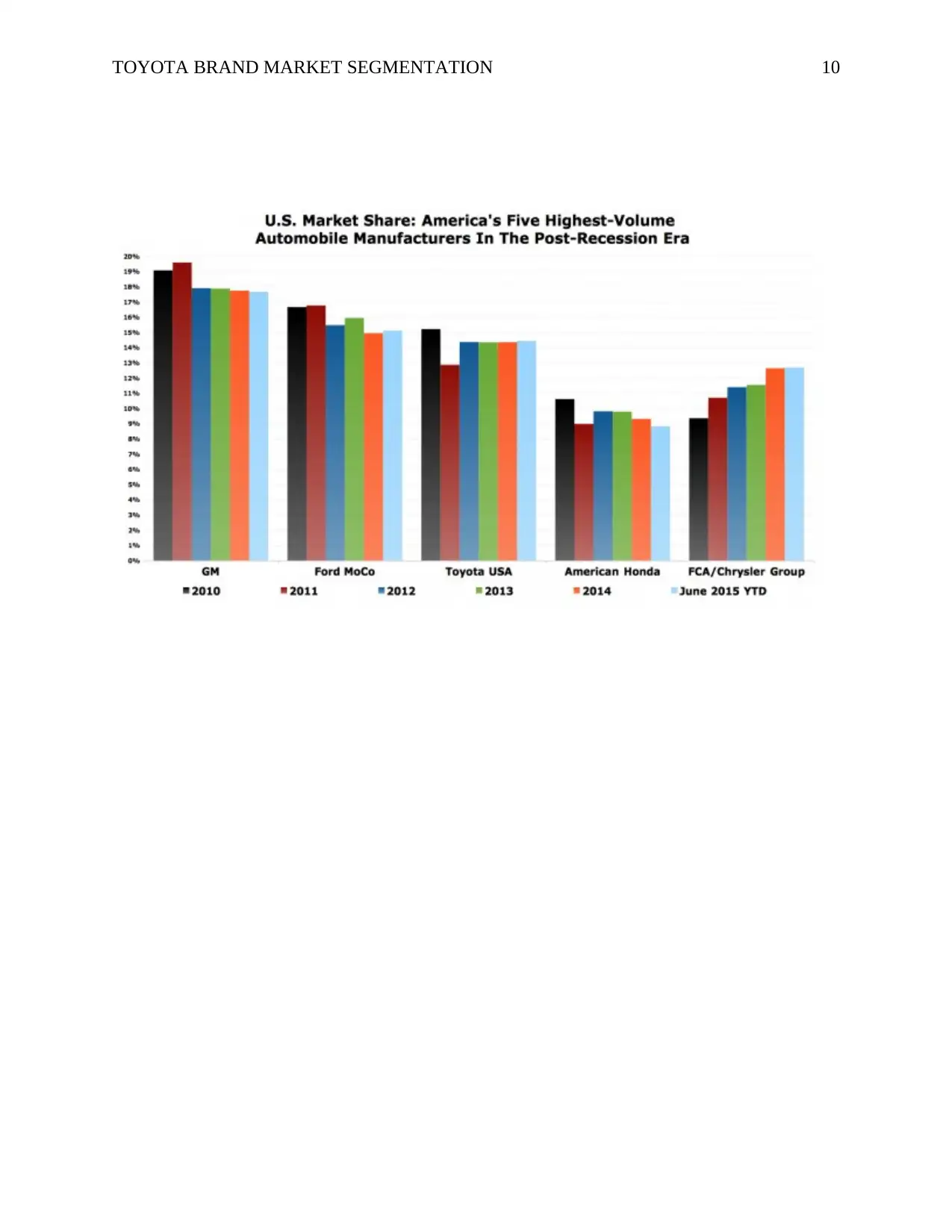
TOYOTA BRAND MARKET SEGMENTATION 10
Paraphrase This Document
Need a fresh take? Get an instant paraphrase of this document with our AI Paraphraser
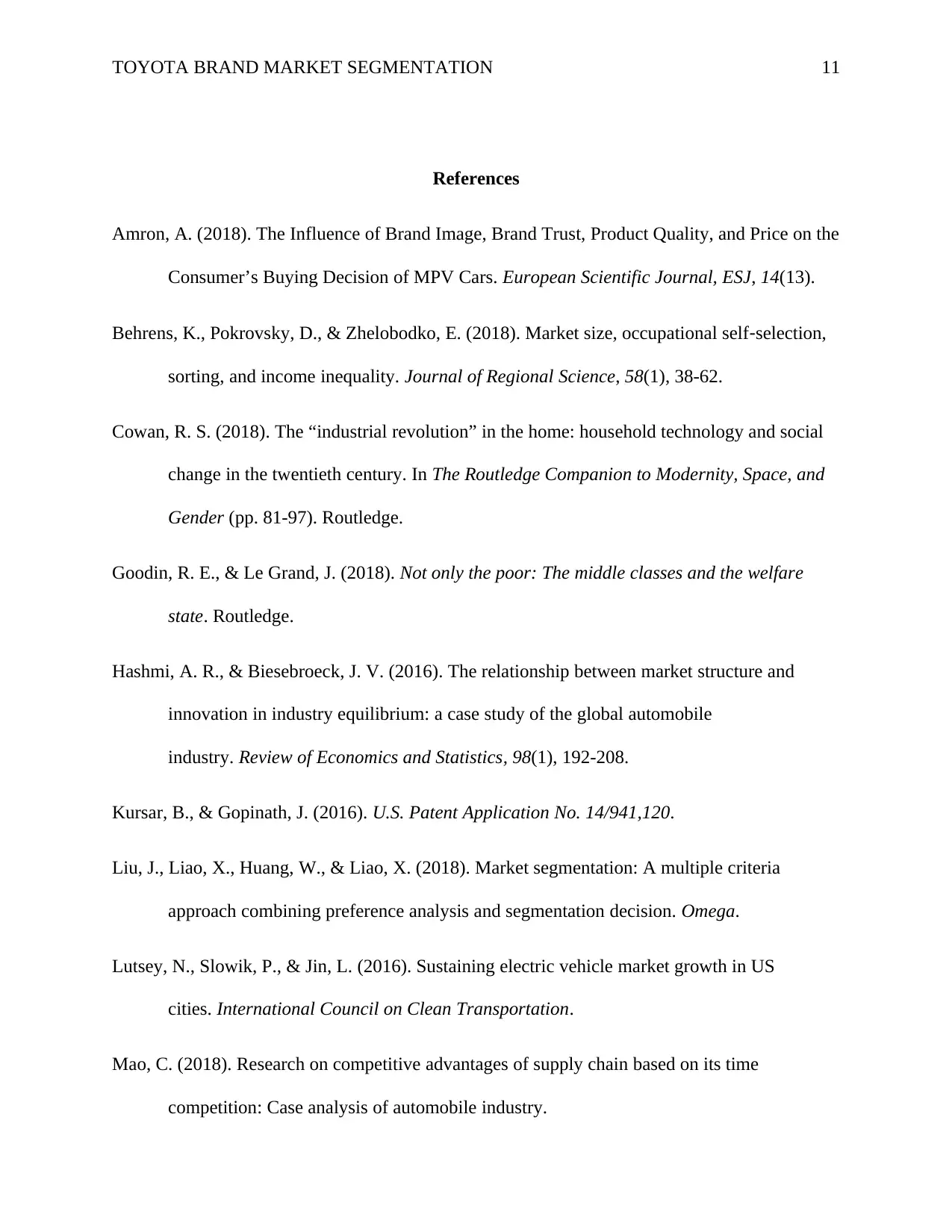
TOYOTA BRAND MARKET SEGMENTATION 11
References
Amron, A. (2018). The Influence of Brand Image, Brand Trust, Product Quality, and Price on the
Consumer’s Buying Decision of MPV Cars. European Scientific Journal, ESJ, 14(13).
Behrens, K., Pokrovsky, D., & Zhelobodko, E. (2018). Market size, occupational self‐selection,
sorting, and income inequality. Journal of Regional Science, 58(1), 38-62.
Cowan, R. S. (2018). The “industrial revolution” in the home: household technology and social
change in the twentieth century. In The Routledge Companion to Modernity, Space, and
Gender (pp. 81-97). Routledge.
Goodin, R. E., & Le Grand, J. (2018). Not only the poor: The middle classes and the welfare
state. Routledge.
Hashmi, A. R., & Biesebroeck, J. V. (2016). The relationship between market structure and
innovation in industry equilibrium: a case study of the global automobile
industry. Review of Economics and Statistics, 98(1), 192-208.
Kursar, B., & Gopinath, J. (2016). U.S. Patent Application No. 14/941,120.
Liu, J., Liao, X., Huang, W., & Liao, X. (2018). Market segmentation: A multiple criteria
approach combining preference analysis and segmentation decision. Omega.
Lutsey, N., Slowik, P., & Jin, L. (2016). Sustaining electric vehicle market growth in US
cities. International Council on Clean Transportation.
Mao, C. (2018). Research on competitive advantages of supply chain based on its time
competition: Case analysis of automobile industry.
References
Amron, A. (2018). The Influence of Brand Image, Brand Trust, Product Quality, and Price on the
Consumer’s Buying Decision of MPV Cars. European Scientific Journal, ESJ, 14(13).
Behrens, K., Pokrovsky, D., & Zhelobodko, E. (2018). Market size, occupational self‐selection,
sorting, and income inequality. Journal of Regional Science, 58(1), 38-62.
Cowan, R. S. (2018). The “industrial revolution” in the home: household technology and social
change in the twentieth century. In The Routledge Companion to Modernity, Space, and
Gender (pp. 81-97). Routledge.
Goodin, R. E., & Le Grand, J. (2018). Not only the poor: The middle classes and the welfare
state. Routledge.
Hashmi, A. R., & Biesebroeck, J. V. (2016). The relationship between market structure and
innovation in industry equilibrium: a case study of the global automobile
industry. Review of Economics and Statistics, 98(1), 192-208.
Kursar, B., & Gopinath, J. (2016). U.S. Patent Application No. 14/941,120.
Liu, J., Liao, X., Huang, W., & Liao, X. (2018). Market segmentation: A multiple criteria
approach combining preference analysis and segmentation decision. Omega.
Lutsey, N., Slowik, P., & Jin, L. (2016). Sustaining electric vehicle market growth in US
cities. International Council on Clean Transportation.
Mao, C. (2018). Research on competitive advantages of supply chain based on its time
competition: Case analysis of automobile industry.

TOYOTA BRAND MARKET SEGMENTATION 12
Porral, C. C., & Stanton, J. L. (2017). Principles of marketing. ESIC Editorial.
Swar, B. N. (2018). An Exploration Into the Factors Driving Working Professionals Buying
Small Cars. Global Business Review, 19(1), 175-186.
Thomas, J. E. (2016). Exploring Primary Target Market Segment Buyer Motivation for Martial
Arts Businesses. Northcentral University.
Toyota Motor Corporation. (2018). TOYOTA MOTOR CORPORATION GLOBAL WEBSITE.
Retrieved from https://www.toyota-global.com/
Zhou, X., & Wodtke, G. T. (2018). INCOME STRATIFICATION AMONG OCCUPATIONAL
CLASSES IN THE UNITED STATES.
Porral, C. C., & Stanton, J. L. (2017). Principles of marketing. ESIC Editorial.
Swar, B. N. (2018). An Exploration Into the Factors Driving Working Professionals Buying
Small Cars. Global Business Review, 19(1), 175-186.
Thomas, J. E. (2016). Exploring Primary Target Market Segment Buyer Motivation for Martial
Arts Businesses. Northcentral University.
Toyota Motor Corporation. (2018). TOYOTA MOTOR CORPORATION GLOBAL WEBSITE.
Retrieved from https://www.toyota-global.com/
Zhou, X., & Wodtke, G. T. (2018). INCOME STRATIFICATION AMONG OCCUPATIONAL
CLASSES IN THE UNITED STATES.
⊘ This is a preview!⊘
Do you want full access?
Subscribe today to unlock all pages.

Trusted by 1+ million students worldwide
1 out of 12
Related Documents
Your All-in-One AI-Powered Toolkit for Academic Success.
+13062052269
info@desklib.com
Available 24*7 on WhatsApp / Email
![[object Object]](/_next/static/media/star-bottom.7253800d.svg)
Unlock your academic potential
Copyright © 2020–2025 A2Z Services. All Rights Reserved. Developed and managed by ZUCOL.





